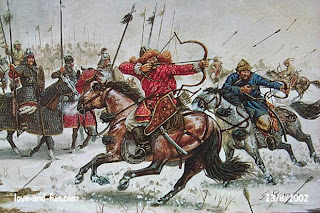Orlok Tusbodai Bahadur.
Orlok Tusbodai (aka Subutai) was the primary military strategist and general of Genghis Khan and Ögedei Khan. He directed more than twenty campaigns in which he conquered thirty-two nations and won sixty-five pitched battles, during which he conquered or overran more territory than any other commander in history. He gained victory by means of imaginative and sophisticated strategies and routinely coordinated movements of armies that were hundreds of kilometers away from each other. He is also remembered for devising the campaign that destroyed the armies of Hungary and Poland within two days of each other, by forces over five hundred kilometers apart. Orlok was the title given the the Commander of Mongol Army.
Historians believe Subutai was born in the year 1175, probably just west of the upper Onon River in what is now Mongolia. He belonged to the Uriankhai clan. Subutai's family had been associated with the family of Temujin (future Genghis Khan) for many generations.He was a commoner by birth, the son of Jarchiudai, who was supposedly a blacksmith. Qaban brought his son to serve Genghis Khan when Subutai was about 17 years old, and he rose to the very highest command available to one who was not a blood relative to Genghis. Within a decade he rose to become a general, in command of one of 4 tumens operating in the vanguard. In 1212 he took Huan by storm, the first major independent exploit mentioned in the sources. Genghis Khan called him one of his "dogs of war", a title he earned through his campaigns.He was given the title of 'Bahadur' that is translated to mean 'The Valiant'.
Subutai was one of the first Mongol generals besides Genghis Khan who realized the value of engineers in siege warfare. Even in field battles he made use of siege engines, much as Chinese armies had in their own wars. In the Battle of Mohi, the Hungarian crossbowmen repelled a night bridge crossing by the Mongols, and inflicted considerable casualties on the Mongols fighting to cross the river the following day. Subutai ordered huge stonethrowers to clear the bank of Hungarian crossbowmen and open the way for his light cavalry to cross the river without further losses. This use of siege weapons was one of the first recorded use in the West of artillery outside of siege warfare. While the stonethrowers were clearing the path to cross the main bridge, Subutai supervised construction of another temporary bridge downriver to outflank the Hungarians.
Subutai was also well known for incorporating conquered peoples who brought specialized skills into his forces, especially engineers. He was skilled at intelligence gathering and planning his campaigns well in advance. For instance, he used spies to gather information on the Russian principalities, the Poles, and the Hungarians at least a year before the attacks on each. He tailored his strategy to match the enemy, adjusting his tactics according to the opponents, the terrain, and the weather as required. He emphasized the use of light cavalry in his army, maneuvering the enemy into feints and ambushes, and efficiently pursuing and defeating broken armies to destroy further resistance. Subutai kept his forces in line with the Mongol tradition of dispensing with excess baggage train and ensured his troops could efficiently live off the land and rapidly advance great distances on campaign. He preferred to maneuver the enemy into a position of weakness before committing to battle.

One of the most remarkable victories among all of Subatais victories, is the one where he beat of the Russian Army. Till date no other army in the world has ever beaten the Russians in winter. The icy temperature of Russia in winter is a natural threat in itself against any invading army. But even nature could not stop Subatai Bahadur. The Mongols rode over the frozen Moscow river in the dead of the night in probably their best-remembered attack on Russia, frightening the unprepared natives who traditionally avoided warfare in the colder months. He used the 'encircling strategy' against the heavy Russian knights. He knew that heavy cavalry had a major weakness. They are built to charge and couldnt turn quickly. Subatai used his fast moving cavalry archers to encircle them and attack from their exposed sides. This tactic required immense discipline and timing. Subatai was a master of both. The Russian heavy knights were no match for the speed and accuracy of the Mongols Archers.
The major reason behind his victories, all of which were won against larger armies, lay in Subatais understand of enemy tactics and there weakness.
He may be a forgotten memory on the sands of time now, but history stands witness of the sheer cunning and ferocity of the Mongols under the leadership of Tusbodai Bahadur, who brought ancient Asia to its knees.


Post a Comment